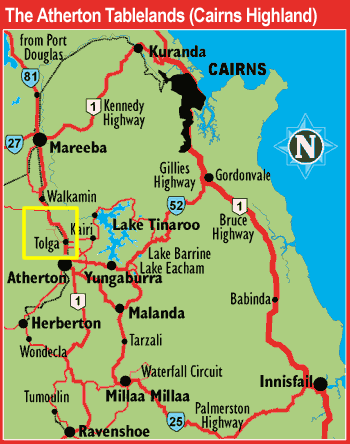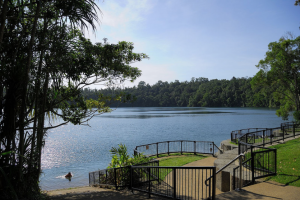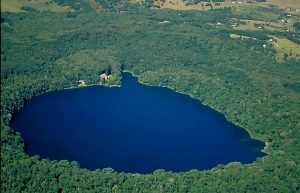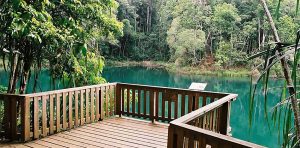 Lake Eacham is an extinct volcanic crater lake located on the Atherton Tablelands; around 4.5 hours drive North East from Townsville. Once you get to Innisfail, take the Hwy 25 turnoff which will take you to Millaa Millaa on the Palmerston Highway, and then on to Malanda. As you come into the Malanda Township, take the Lake Barrine Road, and then finally Lakes Drive.
Lake Eacham is an extinct volcanic crater lake located on the Atherton Tablelands; around 4.5 hours drive North East from Townsville. Once you get to Innisfail, take the Hwy 25 turnoff which will take you to Millaa Millaa on the Palmerston Highway, and then on to Malanda. As you come into the Malanda Township, take the Lake Barrine Road, and then finally Lakes Drive.
Dive instructional bodies such as PADI and SSI classify diving above 300m as altitude diving, and recommend taking some basic precautions to lessen the risk of DSC. These include giving your body at least six hours to acclimatise to the new altitude when you reach your destination. Considering Lake Eacham is positioned 820m above sea level, it is wise to plan your first dive for the day after your arrival.
When you approach the lake, try and find a park in the second car park, closer to the day use area and the boat ramp because this area provides the easiest entry and exit. There are grass areas just above the entry steps which are ideal for gearing up. Two things you may want to consider at this point are water temperature and buoyancy.
- We dived Lake Eacham at Easter, with the water temperature at 23 degrees which you may find cool if you’ve been sweltering through a North QLD summer.
- The difference between your weighting for salt and fresh water can be surprising! I started with a 3mm wetsuit and 6kg of weight. I soon removed 2kg, and was even considering shedding a further 2kg.


Another pleasant aspect of diving in the lake (other than not having to wash salt from your gear) is the lack of water movement. You get a true sense for how much propulsion your fins can give you in perfect conditions, when you don’t have to battle against the wave action, surge, and current typical to ocean dives.
Before heading away from the day use area, spend a few minutes around the base of the boat ramp as there is a resident school of rifle (archer) fish in this area, and they are very inquisitive. If you’re looking to work your way around the edge of the Lake, head in a clockwise direction towards the turtle viewing platform as the shoreline structure in this direction is more interesting than that found north of the day use area. A lot of trees have fallen over the edge into the lake which creates a dappled sunlight effect. You will find cardinal fish hanging motionless under tree limbs and branches, and look out for red claw crabs especially in hollow logs. Locals believe a fresh water crocodile lives around the turtle viewing platform, but it is hard to imagine the lake would support enough fish of large size to provide a food source for it.
 Apparently the lake has been the subject of an inland fisheries stocking program including rainbow and brown trout, although it proved unsuccessful due to the low nutrient content and slightly acidic nature of the water.
Apparently the lake has been the subject of an inland fisheries stocking program including rainbow and brown trout, although it proved unsuccessful due to the low nutrient content and slightly acidic nature of the water.
When you pass the turtle viewing platform you’ll start to swim around the base of an inlet which from an aerial view looks like a small notch coming off the lake. There are old mooring buoys in this area, possibly left over from pontoons. Depth around the moorings is around 6m to 8m, and if you follow the lines, be careful not to fin too closely to the bottom as even the slightest kick will stir up the sediment on the floor of the lake.
If you are keen to explore deeper sections of the lake, then you will find timber boats, with You-Tube footage suggesting they lie in around 25m. According to locals we spoke to, lanes and street signs have been placed on the bottom marking the path required to the get to the timber boats from the day use area. Free divers have filmed themselves diving down to the boats and sitting in their open seats, and Lake Eacham also attracts technical divers and Closed Circuit Divers who use the centre of the lake to achieve deeper dives;
Some recommendations:
- Visibility in Lake Eacham seemed to be a fairly consistent 5m to 6m over the days we dived, although there are plenty of video clips around which suggest much better conditions can be found.
- You will need to dive with an altitude adjusted computer, preferably wrist mounted to reduce the chances of a gauge console touching the bottom and stirring up sediment.
- Lake Eacham is very popular, both with locals and tourists. To get a car park close to the day use area you will need to arrive early.
